An Adaptive Parameterized Domain Mapping Method and Its Application in Wheel–Rail Coupled Fault Diagnosis for Rail Vehicles
Abstract
1. Introduction
1.1. Motivation and Incitement
1.2. Literature Review
1.3. Contribution and Paper Organization
- (1)
- The purpose of this paper is to diagnose wheel–rail coupled faults. Vibration signals of an axle box under coupled faults are more complex than those under single faults. Hence, it is difficult to distinguish separate faults from vibration signals of an axle box under coupled faults using traditional methods.
- (2)
- Rényi entropy is taken as an optimization objective to evaluate the performance of the method proposed in this paper to improve the energy concentration of TFR.
- (3)
- A comparison is carried out between PSO, SSA and WOA to evaluate their performance during the optimization process. The WOA adopted in this paper achieves higher accuracy at a faster speed.
- (4)
- Compared with STFT and PDM, the APDM proposed in this paper has a better diagnostic effect and better performance, including higher energy concentration and stronger noise resistance.
2. Models of Rail Vehicles and Wheel–Rail Faults
2.1. Dynamic Model of Rail Vehicles
2.2. Fault Modeling
2.2.1. Rail Corrugation
2.2.2. Wheel Polygon
2.2.3. Flat Scar
2.2.4. Dynamic Characteristics and Signal Features of Coupled Faults
3. Adaptive Parameterized Domain Mapping Method Based on Whale Optimization Algorithm
3.1. Basic Theory of Parameterized Domain Mapping
3.2. Optimization of Parameterized Domain Mapping
3.2.1. Whale Optimization Algorithm
3.2.2. Optimization Index Rényi Entropy
3.3. Optimization Framework
3.4. Performance Evaluation of Algorithm
4. Simulation and Experimental Verification
4.1. Rail Corrugation–Polygon Coupled Fault Signal Analysis
4.1.1. Setting of Traction Condition
4.1.2. Time–Frequency Characteristics under Traction Condition
4.1.3. Setting of Braking Condition
4.1.4. Time–Frequency Characteristics under Braking Conditions
4.2. Analysis of Rail Corrugation–Flat Scar Coupled Fault
4.3. Discussions and Summaries
4.4. Experimental Verification of Field-Tested Data
5. Conclusions
- (1)
- A comparison was carried out between PSO, SSA and WOA to evaluate their performance during the optimization process. The number of iterations of WOA adopted in this paper decreased by 26% and 23%, respectively, compared with PSO and SSA, which means that the WOA performs faster in terms of convergence speed and has a more accurate Rényi entropy value;
- (2)
- Compared with STFT and PDM, APDM achieves the advantages of accurate fault frequency location, high energy concentration and excellent noise resistance.
Author Contributions
Funding
Institutional Review Board Statement
Informed Consent Statement
Data Availability Statement
Conflicts of Interest
Nomenclature
| APDM | Adaptive parameterized domain mapping. |
| STFT | Short-time Fourier transform. |
| WT | Wavelet transform. |
| ASTFT | Adaptive short-time Fourier transform. |
| TFR | Time–frequency representation. |
| TFA | Time–frequency analysis. |
| IF | Instantaneous frequency. |
| GPTF | Generalized parameterized time–frequency transform. |
| PDM | Parameterized domain mapping. |
| PDMF | Parameterized domain mapping function. |
| WOA | Whale optimization algorithm. |
| MTNCM | Mono-trend nonlinear chirp modes. |
| GD | Generalized demodulation. |
| TLOT | Tacholess order tracking. |
| PSO | Particle swarm optimization. |
| SSA | Sparrow algorithm optimization. |
| RTF | Relative trend function. |
References
- Kalousek, J.; Johnson, K.L. An investigation of short pitch wheel and rail corrugations on the Vancouver mass transit system. Proc. Inst. Mech. Eng. Part F J. Rail Rapid Transit 1992, 206, 127–135. [Google Scholar] [CrossRef]
- Nielsen, J.C.O.; Lundn, R.; Johansson, A.; Vernersson, T. Train-Track Interaction and Mechanisms of Irregular Wear on Wheel and Rail Surfaces. Veh. Syst. Dyn. 2003, 40, 3–54. [Google Scholar] [CrossRef]
- Meywerk, M. Polygonalization of railway wheels. Arch. Appl. Mech. 1999, 69, 105–120. [Google Scholar] [CrossRef]
- Johansson, A. Out-of-Round Railway Wheels—Causes and Consequences an Investigation Including Field Tests, Out-of-Roundness Measurements and Numerical Simulations. Ph.D. Thesis, Chalmers Tekniska Hogskola, Gothenburg, Sweden, 2005; pp. 1–43. [Google Scholar]
- Jin, X.; Wu, L.; Fang, J.; Zhong, S.; Ling, L. An investigation into the mechanism of the polygonal wear of metro train wheels and its effect on the dynamic behaviour of a wheel/rail system. Veh. Syst. Dyn. 2012, 50, 1817–1834. [Google Scholar] [CrossRef]
- Kumagai, N.; Ishikawa, H.; Haga, K.; Kigawa, T.; Nagase, K. Factors of wheel flats occurrence and preventive measures. Wear 1991, 144, 277–287. [Google Scholar] [CrossRef]
- Zhai, W.M.; Wang, Q.C.; Lu, Z.W.; Wu, X.S. Dynamic effects of vehicles on tracks in the case of raising train speeds. Proc. Inst. Mech. Eng. Part F J. Rail Rapid Transit 2005, 215, 125–135. [Google Scholar] [CrossRef]
- Xu, X.; Liu, J.; Sun, S.; Niu, L.; Mao, X. Dynamic diagnosis method and quantitative characterization of rail corrugation. Proc. Inst. Mech. Eng. Part F J. Rail Rapid Transit 2022, 237, 297–308. [Google Scholar] [CrossRef]
- Suda, Y.; Okumura, M.; Komine, H.; Iwasa, T.; Qian, B.; Terumichi, Y. Study on Detecting Method of Railway Corrugation Using Wavelet Analysis. Trans. Jpn. Soc. Mech. Eng. 2000, 66, 615–620. [Google Scholar] [CrossRef]
- Chen, X.; Fan, Y.; Li, F. Wheel Polygon Fault Diagnosis Based on the Time and requency Domain Characteristics of Axle Box Acceleration. Machinery 2021, 48, 9. [Google Scholar]
- Yang, L.; He, Z.; Wang, K.; Liu, X.; Cao, Z. Research on Recognition of Wheel Flat Scars Using Wheel-Rail Vibration Acceleration Signal. Mech. Sci. Technol. Aerosp. Eng. 2023, 48, 1–8. [Google Scholar] [CrossRef]
- Xu, X.; Cui, X.; Xu, J.; Wen, X.; Yang, Z. Study on the Interaction between Wheel Polygon and Rail Corrugation in High-Speed Railways. Materials 2022, 15, 8765. [Google Scholar] [CrossRef]
- Liu, P.; Yang, S.; Liu, Y. Full-scale test and numerical simulation of wheelset-gear box vibration excited by wheel polygon wear and track irregularity. Mech. Syst. Signal Process. 2022, 167, 108515. [Google Scholar] [CrossRef]
- Avargel, Y.; Cohen, I. Adaptive Nonlinear System Identification in the Short-Time Fourier Transform Domain. IEEE Trans. Signal Process. 2009, 57, 3891–3904. [Google Scholar] [CrossRef]
- Zhong, J.; Huang, Y. Time-Frequency Representation Based on an Adaptive Short-Time Fourier Transform. IEEE Trans. Signal Process. 2010, 58, 5118–5128. [Google Scholar] [CrossRef]
- Cai, H.; Jiang, Q.; Li, L.; Suter, B.W. Analysis of adaptive short-time Fourier transform-based synchrosqueezing transform. Anal. Appl. 2020, 19, 71–105. [Google Scholar] [CrossRef]
- Guo, Y.; Fang, Z.; Chen, X. A new improved Synchrosqueezing Transform based on adaptive short time fourier transform. In Proceedings of the 2014 IEEE Far East Forum on Nondestructive Evaluation/Testing, Chengdu, China, 20–23 June 2014; pp. 329–334. [Google Scholar]
- Wang, X.; Ying, T.; Tian, W. Spectrum Representation Based on STFT. In Proceedings of the 2020 13th International Congress on Image and Signal Processing, BioMedical Engineering and Informatics (CISP-BMEI), Chengdu, China, 17–19 October 2020; pp. 435–438. [Google Scholar]
- Wei, M.; Yang, J.; Yao, D.; Wang, J.; Hu, Z. Fault diagnosis of bearings in multiple working conditions based on adaptive time-varying parameters short-time Fourier synchronous squeeze transform. Meas. Sci. Technol. 2022, 33, 124002. [Google Scholar] [CrossRef]
- Chen, J.; Li, Z.; Pan, J.; Chen, G.; Zi, Y.; Yuan, J.; Chen, B.; He, Z. Wavelet transform based on inner product in fault diagnosis of rotating machinery: A review. Mech. Syst. Signal Process. 2016, 70–71, 1–35. [Google Scholar] [CrossRef]
- Huang, Y.; Bao, W.; Li, F.; Li, X. Sparse Time-Frequency Analysis Based on Instantaneous Frequency Estimation and Fault Diagnosis Application. IEEE Trans. Instrum. Meas. 2022, 71, 3525509. [Google Scholar] [CrossRef]
- Hu, Z.; Yang, J.; Yao, D.; Wang, J.; Bai, Y. Subway Gearbox Fault Diagnosis Algorithm Based on Adaptive Spline Impact Suppression. Entropy 2021, 23, 660. [Google Scholar] [CrossRef]
- Shi, J.; Chen, G.; Zhao, Y.; Tao, R. Synchrosqueezed Fractional Wavelet Transform: A New High-Resolution Time-Frequency Representation. IEEE Trans. Signal Process. 2023, 71, 264–278. [Google Scholar] [CrossRef]
- Yang, Y.; Peng, Z.; Zhang, W.; Meng, G. Parameterised time-frequency analysis methods and their engineering applications: A review of recent advances. Mech. Syst. Signal Process. 2019, 119, 182–221. [Google Scholar] [CrossRef]
- Olhede, S.; Walden, A.T. A generalized demodulation approach to time-frequency projections for multicomponent signals. Proc. R. Soc. A Math. Phys. Eng. Sci. 2005, 461, 2159–2179. [Google Scholar] [CrossRef]
- Huang, W.; Gao, G.; Li, N.; Jiang, X.; Zhu, Z. Time-Frequency Squeezing and Generalized Demodulation Combined for Variable Speed Bearing Fault Diagnosis. IEEE Trans. Instrum. Meas. 2019, 68, 2819–2829. [Google Scholar] [CrossRef]
- Ma, Z.; Lu, F.; Liu, S.; Li, X. An Adaptive Generalized Demodulation Method for Multimedia Spectrum Analysis is Applied in Rolling Bearing Fault Diagnosis. IEEE Access 2020, 8, 20687–20699. [Google Scholar] [CrossRef]
- Liu, D.; Cui, L.; Cheng, W. Flexible Generalized Demodulation for Intelligent Bearing Fault Diagnosis Under Nonstationary Conditions. IEEE Trans. Ind. Inform. 2023, 19, 2717–2728. [Google Scholar] [CrossRef]
- Bonnardot, F.; El Badaoui, M.; Randall, R.B.; Danière, J.; Guillet, F. Use of the acceleration signal of a gearbox in order to perform angular resampling (with limited speed fluctuation). Mech. Syst. Signal Process. 2005, 19, 766–785. [Google Scholar] [CrossRef]
- Wu, J.; Zi, Y.; Chen, J.; Zhou, Z. A modified tacho-less order tracking method for the surveillance and diagnosis of machine under sharp speed variation. Mech. Mach. Theory 2018, 128, 508–527. [Google Scholar] [CrossRef]
- Jing, S.; Luo, Z.; Leng, J.; Wang, Z. Tacho-less Order Tracking for Gearbox based on Time-varying Filter and CWT. J. Mech. Transm. 2019, 43, 144–149. [Google Scholar]
- Wan, S.; Wang, Y.; Zhang, X.; Gu, X. Tacho-less order tracking method of wind turbine gearbox under time-varying conditions. J. Vib. Eng. 2023, 36, 266–279. [Google Scholar] [CrossRef]
- Yang, Y.; Peng, Z.K.; Dong, X.J.; Zhang, W.M.; Meng, G. General Parameterized Time-Frequency Transform. IEEE Trans. Signal Process. 2014, 62, 2751–2764. [Google Scholar] [CrossRef]
- Yang, Y.; Dong, X.J.; Peng, Z.K.; Zhang, W.M.; Meng, G. Vibration signal analysis using parameterized time–frequency method for features extraction of varying-speed rotary machinery. J. Sound Vib. 2015, 335, 350–366. [Google Scholar] [CrossRef]
- Deng, Y.; Cheng, C.M.; Yang, Y.; Peng, Z.K.; Yang, W.X.; Zhang, W.M. Parametric Identification of Nonlinear Vibration Systems Via Polynomial Chirplet Transform. J. Vib. Acoust. 2016, 138, 051014. [Google Scholar] [CrossRef]
- Chen, S.; Dong, X.; Yang, Y.; Zhang, W.; Peng, Z.; Meng, G. Chirplet Path Fusion for the Analysis of Time-Varying Frequency-Modulated Signals. IEEE Trans. Ind. Electron. 2017, 64, 1370–1380. [Google Scholar] [CrossRef]
- Wang, S.; Yang, L.; Chen, X.; Tong, C.; Ding, B.; Xiang, J. Nonlinear Squeezing Time-Frequency Transform and Application in Rotor Rub-Impact Fault Diagnosis. J. Manuf. Sci. Eng. 2017, 139, 101005. [Google Scholar] [CrossRef]
- Zhou, P.; Peng, Z.; Chen, S.; Yang, Y.; Zhang, W. Non-stationary signal analysis based on general parameterized time–frequency transform and its application in the feature extraction of a rotary machine. Front. Mech. Eng. 2017, 13, 292–300. [Google Scholar] [CrossRef]
- Li, T.; He, Q.; Peng, Z. Parameterized Resampling Time-Frequency Transform. IEEE Trans. Signal Process. 2022, 70, 5791–5805. [Google Scholar] [CrossRef]
- Li, T.; Peng, Z.; Xu, H.; He, Q. Parameterized Domain Mapping for Order Tracking of Rotating Machinery. IEEE Trans. Ind. Electron. 2023, 70, 7406–7416. [Google Scholar] [CrossRef]
- Yang, Y.; Qiu, X.L.; Peng, Z.K. A Comparison Study between Non-parameterized and Parameterized Time-Frequency Representation for Non-stationary Signals. In Proceedings of the 2017 International Conference on Sensing, Diagnostics, Prognostics, and Control (SDPC), Shanghai, China, 16–18 August 2017; pp. 577–584. [Google Scholar]
- Chen, C.; Mu, X.; Niu, B.; Wang, L. Improved Binary Grey Wolves Optimization Algorithm Combined with Gaussian Distribution. Comput. Eng. Appl. 2019, 55, 6. [Google Scholar]
- Bai, Y.; Yang, J.; Wang, J.; Zhao, Y.; Li, Q. Image representation of vibration signals and its application in intelligent compound fault diagnosis in railway vehicle wheelset-axlebox assemblies. Mech. Syst. Signal Process. 2021, 152, 107421. [Google Scholar] [CrossRef]
- He, Z.; Shao, H.; Zhong, X.; Zhao, X. Ensemble transfer CNNs driven by multi-channel signals for fault diagnosis of rotating machinery cross working conditions. Knowl.-Based Syst. 2020, 207, 106396. [Google Scholar] [CrossRef]
- Shao, H.; Li, W.; Xia, M.; Zhang, Y.; Shen, C.; Williams, D.; Kennedy, A.; de Silva, C.W. Fault Diagnosis of a Rotor-Bearing System Under Variable Rotating Speeds Using Two-Stage Parameter Transfer and Infrared Thermal Images. IEEE Trans. Instrum. Meas. 2021, 70, 3524711. [Google Scholar] [CrossRef]
- Bai, Y.; Yang, J.; Wang, J.; Li, Q. Intelligent Diagnosis for Railway Wheel Flat Using Frequency-Domain Gramian Angular Field and Transfer Learning Network. IEEE Access 2020, 8, 105118–105126. [Google Scholar] [CrossRef]
- Wang, J.; Yang, J.; Wang, Y.; Bai, Y.; Zhang, T.; Yao, D. Ensemble decision approach with dislocated time–frequency representation and pre-trained CNN for fault diagnosis of railway vehicle gearboxes under variable conditions. Int. J. Rail Transp. 2021, 10, 655–673. [Google Scholar] [CrossRef]
- Chu, W.; Wang, G.; Liu, T.; Wang, Z. Rolling Bearing Fault Diagnosis Method Based on Parameter Optimization of Sparrow Search Algorithm VMD and K-SVD. Noise Vib. Control 2022, 42, 100–106. [Google Scholar]
- Mirjalili, S.; Lewis, A. The Whale Optimization Algorithm. Adv. Eng. Softw. 2016, 95, 51–67. [Google Scholar] [CrossRef]
- Fehr, S.; Berens, S. On the Conditional Rényi Entropy. IEEE Trans. Inf. Theory 2014, 60, 6801–6810. [Google Scholar] [CrossRef]
- Kennedy, J.; Eberhart, R. Particle swarm optimization. In Proceedings of the ICNN’95—International Conference on Neural Networks, Perth, WA, Australia, 27 November–1 December 1995; Volume 4, pp. 1942–1948. [Google Scholar]
- Xue, J.; Shen, B. A novel swarm intelligence optimization approach: Sparrow search algorithm. Syst. Sci. Control Eng. 2020, 8, 22–34. [Google Scholar] [CrossRef]
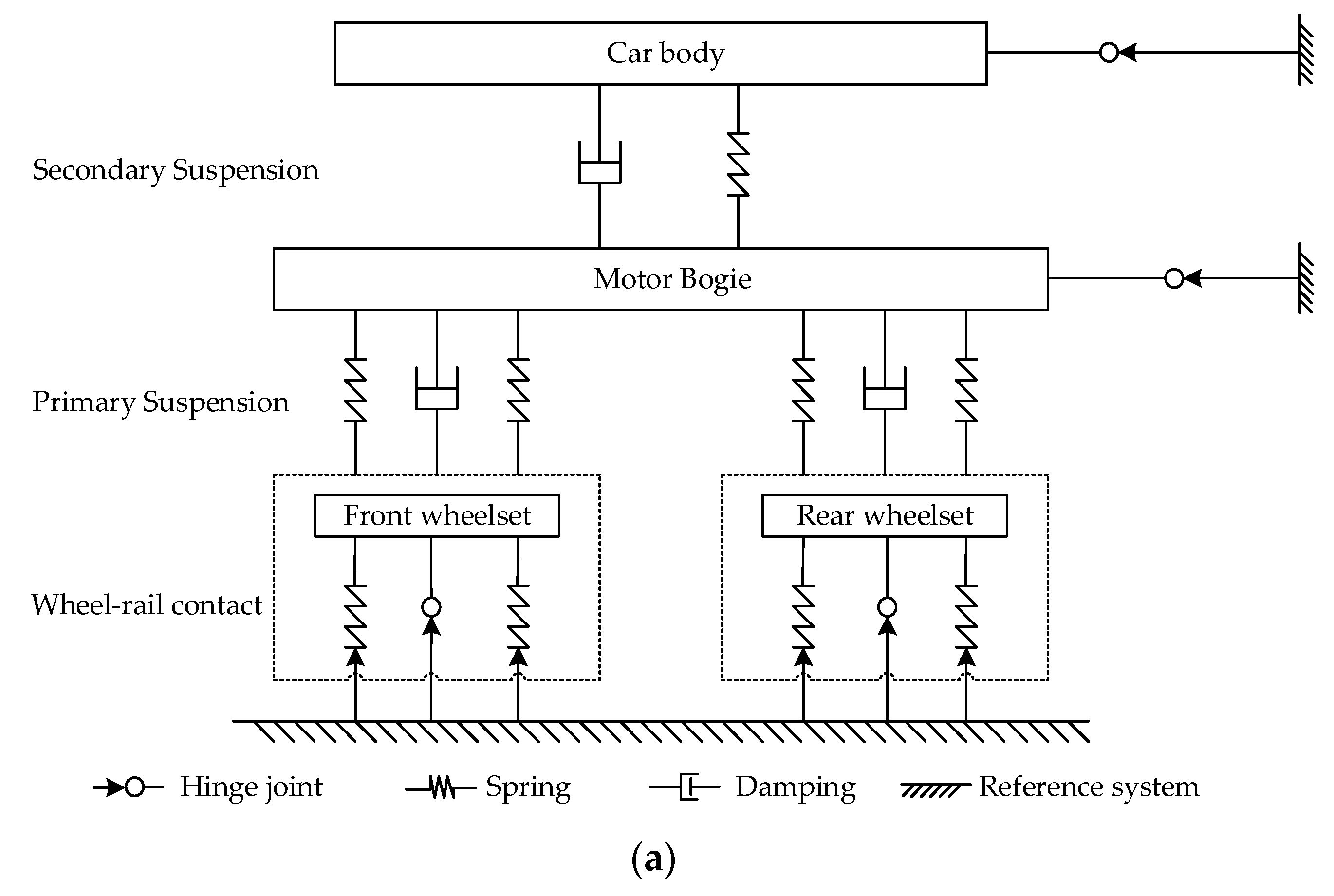
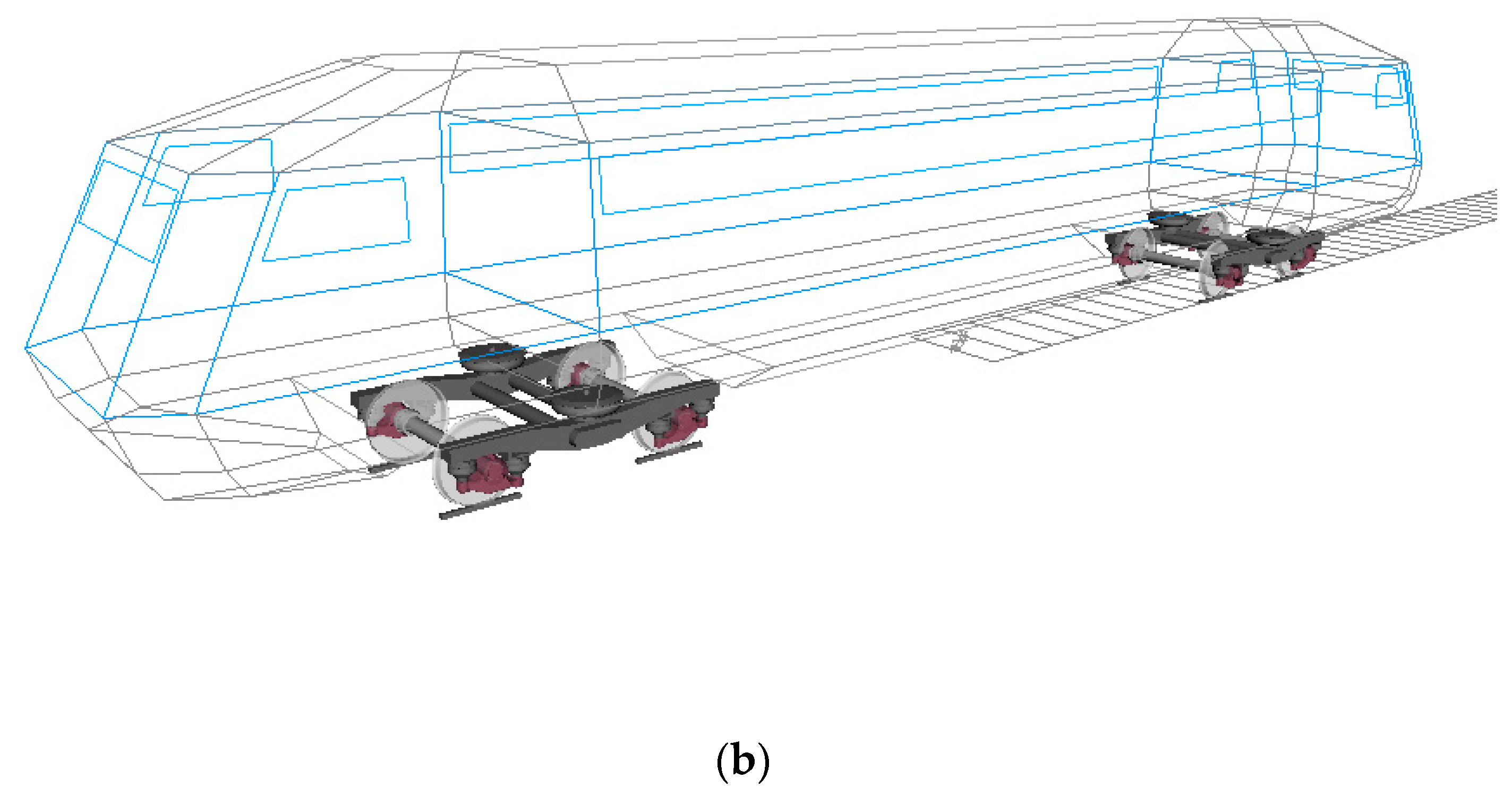





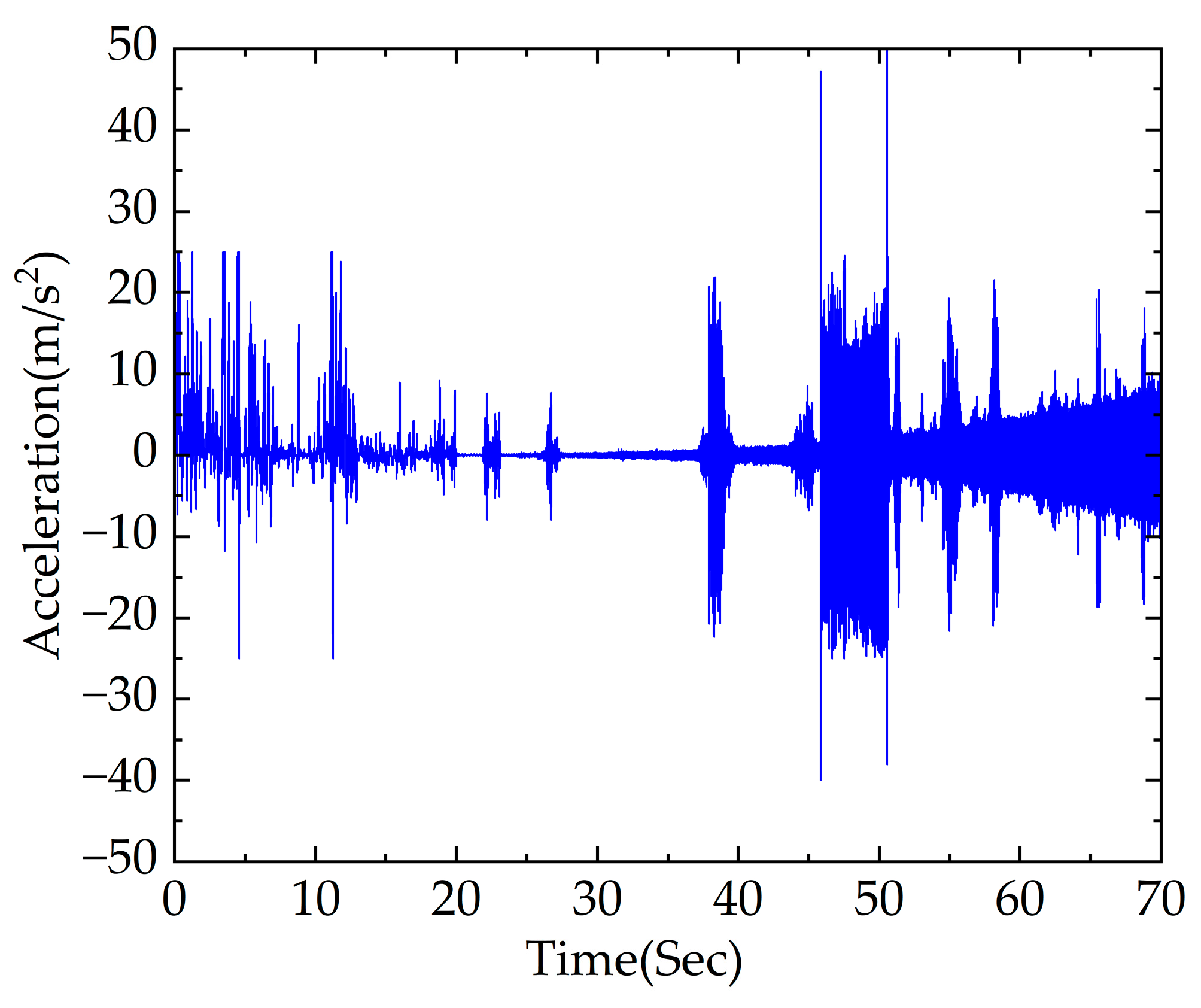

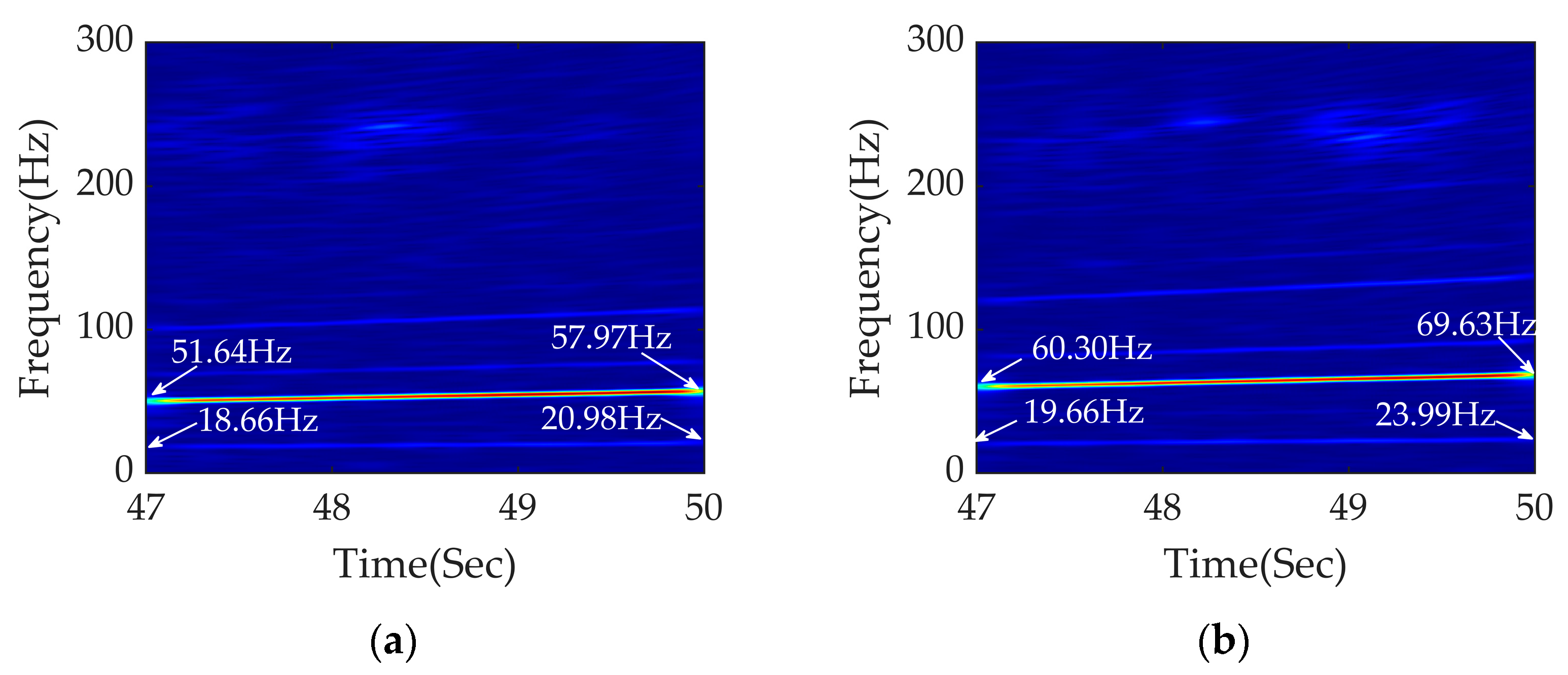
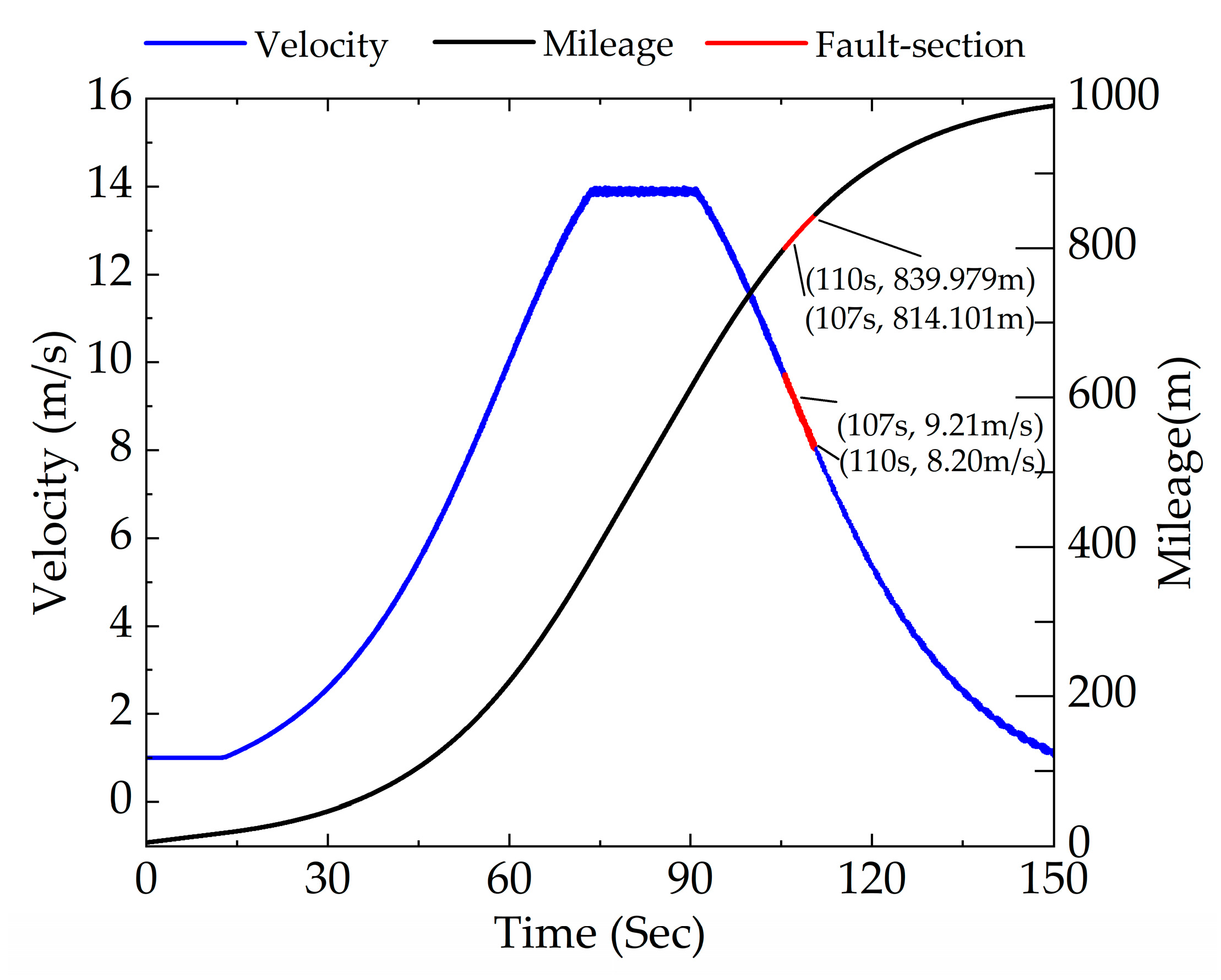
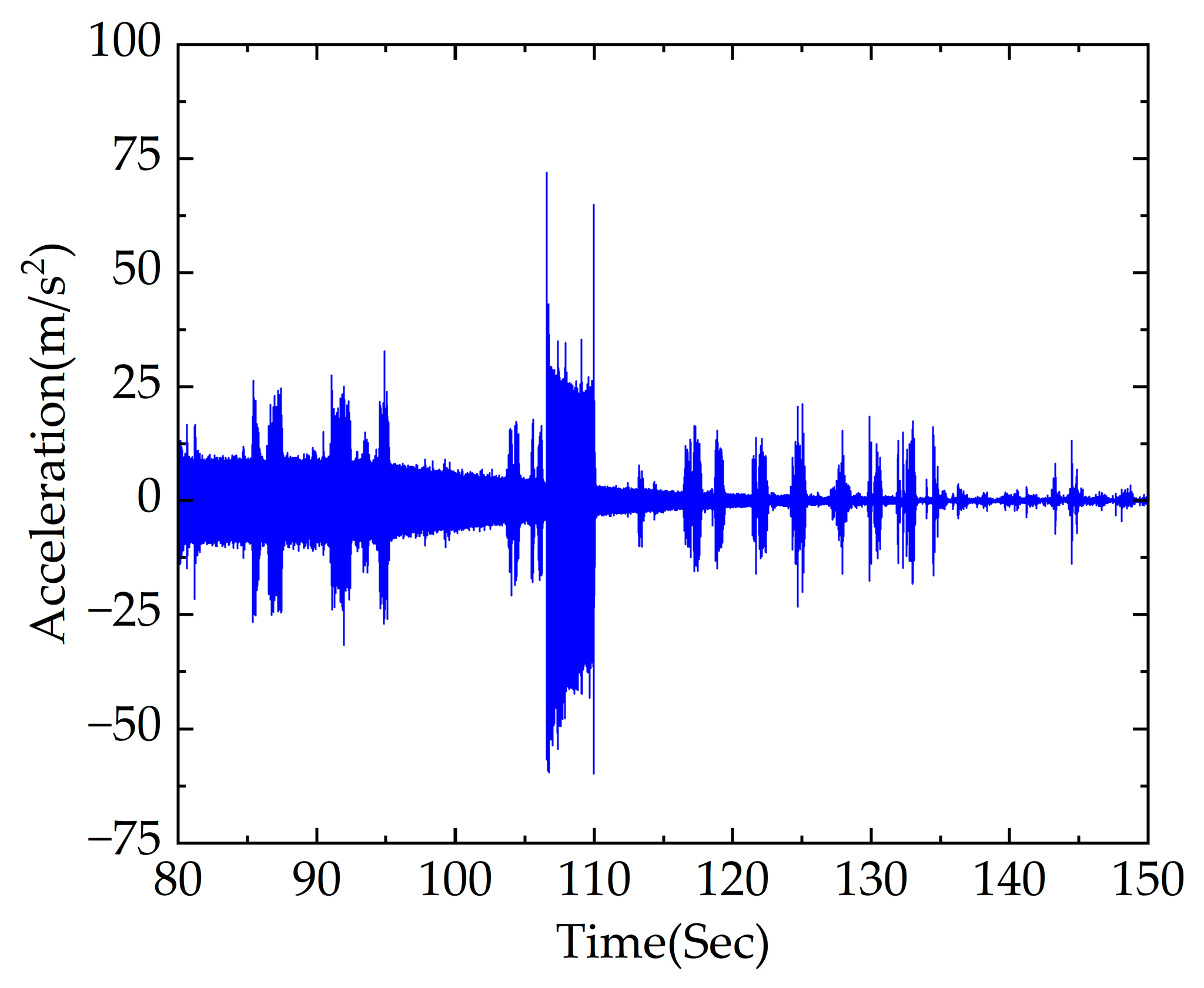
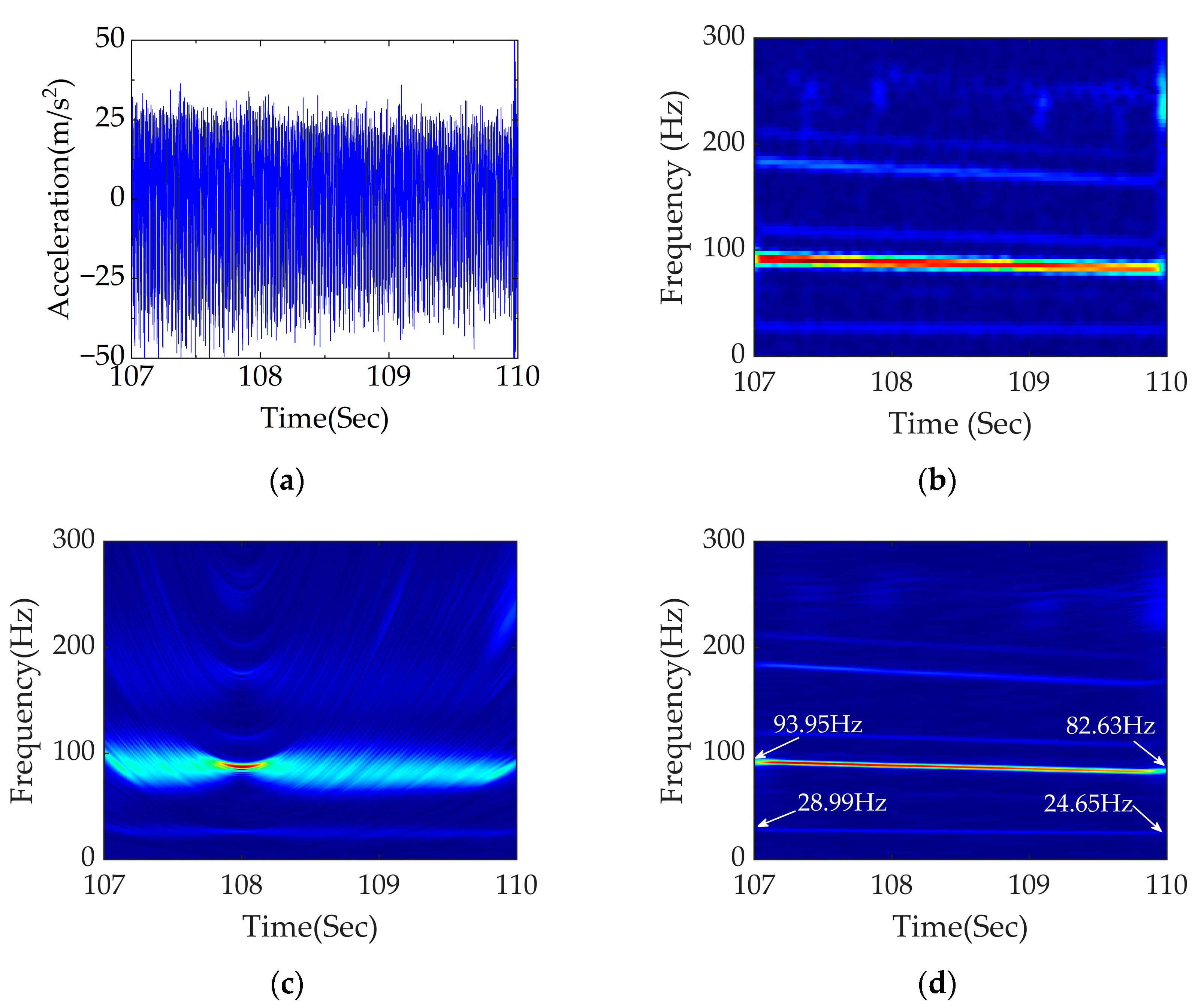
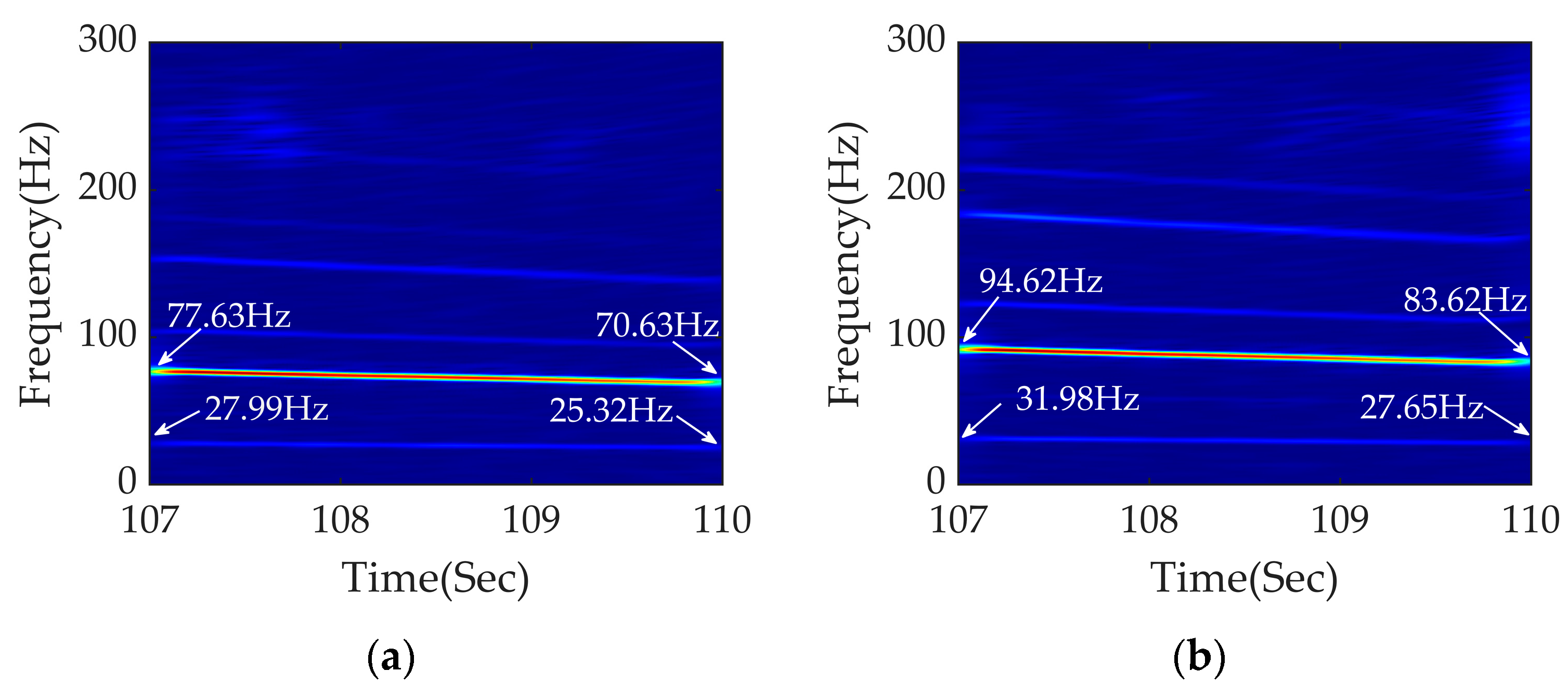

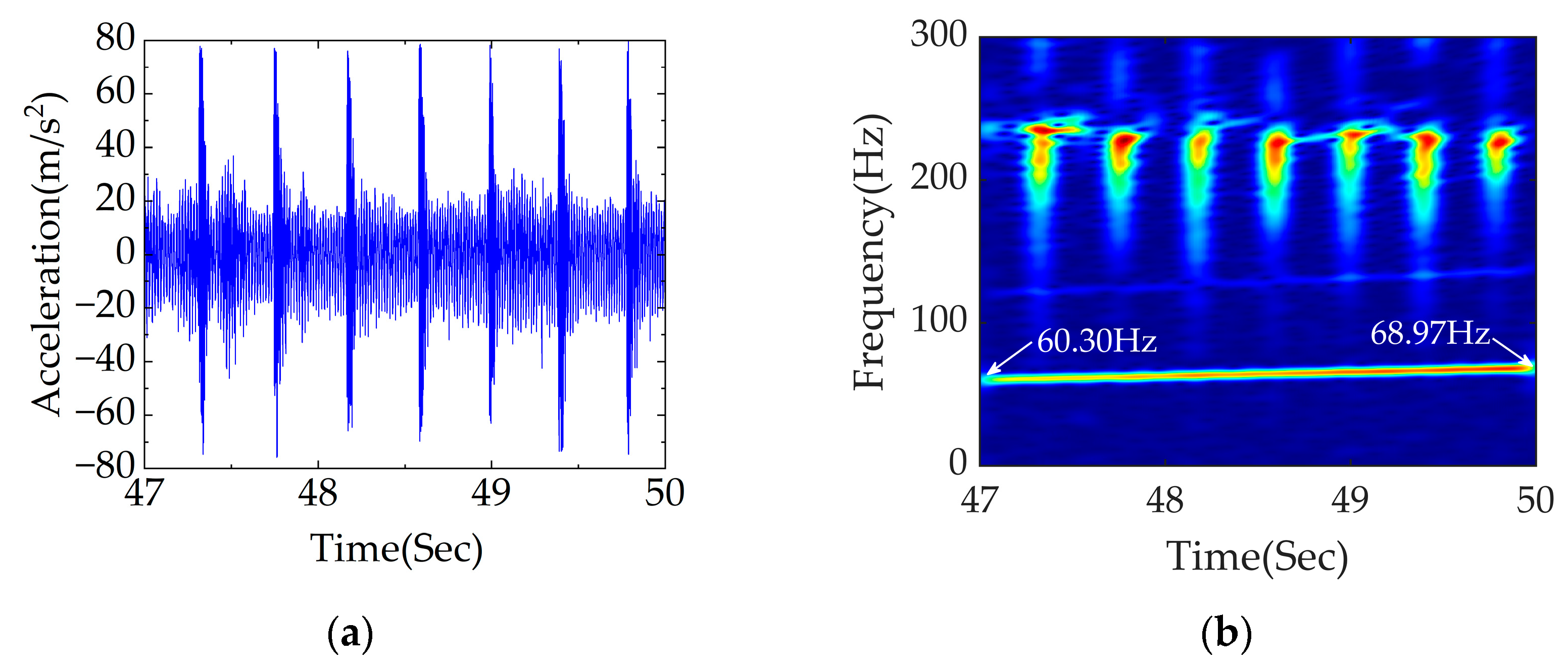
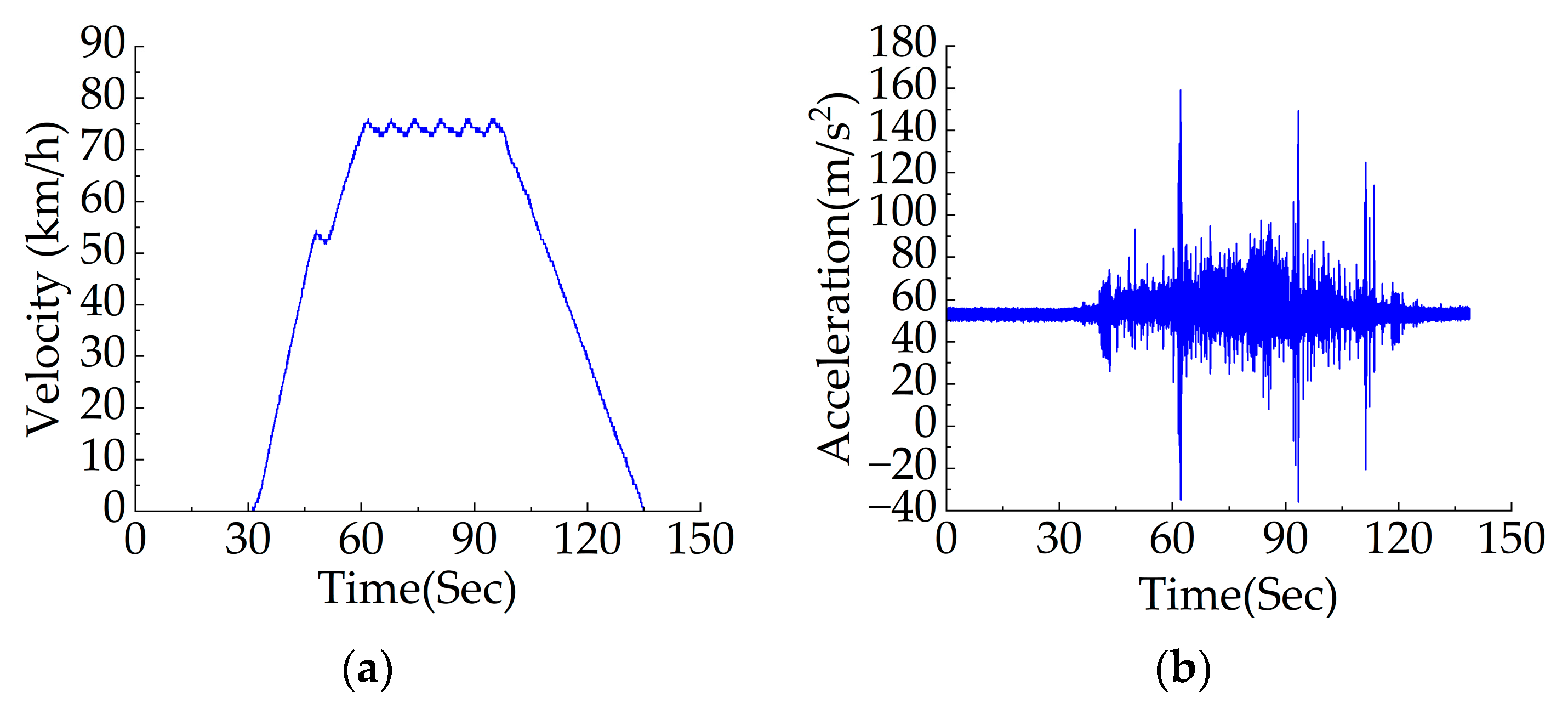
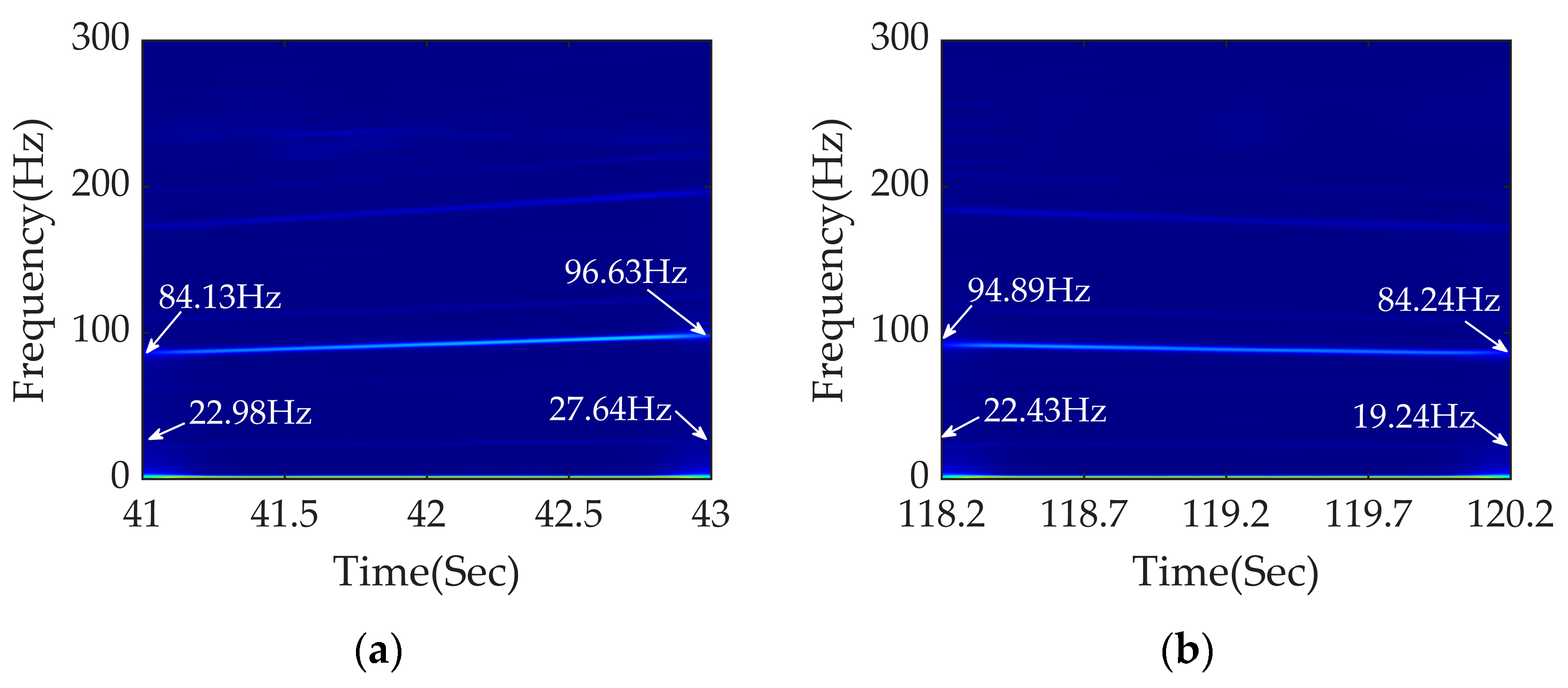
| Algorithms | Desired Iterations | Best Rényi Entropy Obtained |
|---|---|---|
| PSO | 73 | 9.7614 |
| SSA | 70 | 9.7395 |
| WOA | 54 | 9.7389 |
Disclaimer/Publisher’s Note: The statements, opinions and data contained in all publications are solely those of the individual author(s) and contributor(s) and not of MDPI and/or the editor(s). MDPI and/or the editor(s) disclaim responsibility for any injury to people or property resulting from any ideas, methods, instructions or products referred to in the content. |
© 2023 by the authors. Licensee MDPI, Basel, Switzerland. This article is an open access article distributed under the terms and conditions of the Creative Commons Attribution (CC BY) license (https://creativecommons.org/licenses/by/4.0/).
Share and Cite
Xu, Z.; Yang, J.; Yao, D.; Wang, J.; Wei, M. An Adaptive Parameterized Domain Mapping Method and Its Application in Wheel–Rail Coupled Fault Diagnosis for Rail Vehicles. Sensors 2023, 23, 5486. https://doi.org/10.3390/s23125486
Xu Z, Yang J, Yao D, Wang J, Wei M. An Adaptive Parameterized Domain Mapping Method and Its Application in Wheel–Rail Coupled Fault Diagnosis for Rail Vehicles. Sensors. 2023; 23(12):5486. https://doi.org/10.3390/s23125486
Chicago/Turabian StyleXu, Zihang, Jianwei Yang, Dechen Yao, Jinhai Wang, and Minghui Wei. 2023. "An Adaptive Parameterized Domain Mapping Method and Its Application in Wheel–Rail Coupled Fault Diagnosis for Rail Vehicles" Sensors 23, no. 12: 5486. https://doi.org/10.3390/s23125486
APA StyleXu, Z., Yang, J., Yao, D., Wang, J., & Wei, M. (2023). An Adaptive Parameterized Domain Mapping Method and Its Application in Wheel–Rail Coupled Fault Diagnosis for Rail Vehicles. Sensors, 23(12), 5486. https://doi.org/10.3390/s23125486







